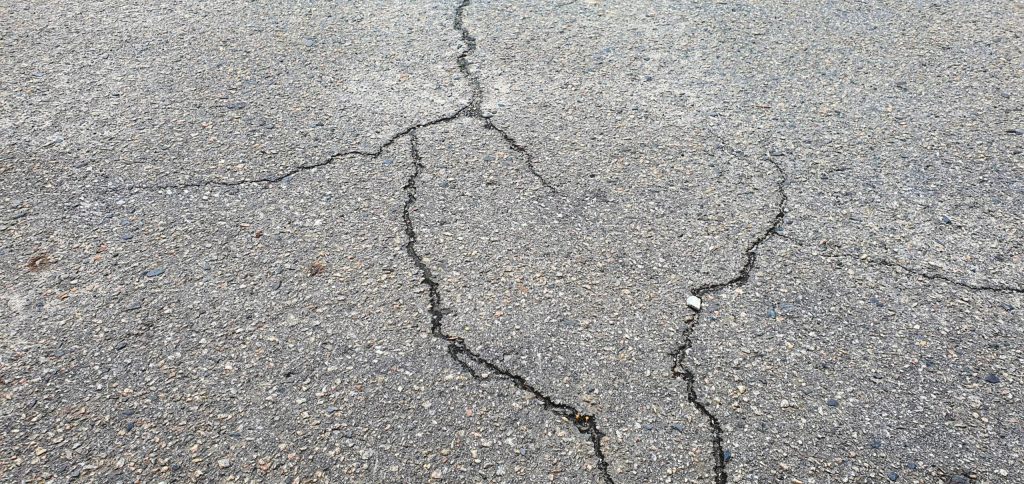Maintaining a well-maintained driveway enhances the curb appeal of your home and ensures safety for you, your family, and visitors. However, like any other part of your home, driveways are subject to wear and tear over time. If left unattended, the signs of damage can quickly escalate, leading to costly repairs.
This blog post will discuss four signs that your driveway needs repairs. We’ll cover cracks, potholes, uneven surfaces, and drainage issues and provide solutions for each problem. So, if you’re wondering whether your driveway needs some repairs, keep reading to learn about the signs you should look out for.
Sign 1: Cracks
One of the most common signs that your driveway needs repairs is the appearance of cracks. Cracks can occur due to various factors, such as heavy traffic, extreme weather conditions, and improper installation. There are different types of cracks, and each type can indicate a specific problem.
For instance, hairline cracks are small and narrow cracks that are less than a quarter-inch wide. They are typically not a significant concern and can be repaired easily with a crack filler. However, if left unattended, hairline cracks can develop into larger cracks, which can lead to more serious problems.
Another type of crack is called alligator cracking, which looks like a series of interconnected cracks that resemble an alligator’s skin. Alligator cracking is a more severe damage, indicating that the pavement’s sub-base has been compromised. This type of crack requires immediate attention, and repairing it may involve removing and replacing the affected section of the driveway.
Ignoring cracks in your driveway can lead to safety hazards, such as tripping, and can cause further damage to your driveway. Therefore, promptly identifying and addressing any cracks in your driveway is essential.
There are various ways to repair cracks in your driveway, depending on the type and severity of the crack. Some repair methods include filling the cracks with a crack filler, patching the cracks with a patching compound, or resurfacing the driveway. It’s best to consult a professional to determine the best approach for repairing the cracks in your driveway.
Sign 2: Potholes
Another sign that your driveway needs repairs is the appearance of potholes. Potholes are typically caused by water seeping into the pavement’s base and freezing and thawing, causing the pavement to expand and contract, which weakens it over time. Heavy traffic can then cause the weakened pavement to break away, forming a pothole.
Potholes can be dangerous for vehicles and pedestrians, as they can cause damage to tires and suspension systems and cause accidents. Additionally, if left unattended, potholes can lead to more significant damage to your driveway and may require costly repairs.
Identifying potholes is relatively easy, as they are typically round or oval-shaped holes in the pavement. They can range from a few inches to several feet in diameter. If you notice any potholes in your driveway, addressing them as soon as possible is essential to prevent further damage.
Repairing potholes in your driveway typically involves filling them with asphalt patching material. The process involves cleaning out the pothole, applying a tack coat to the edges, and filling the pothole with the patching material. The material is then compacted and smoothed to create a level surface.
Sign 3: Uneven Surface
An uneven surface is another sign that your driveway needs repairs. An uneven driveway surface can be caused by a variety of factors, including soil settlement, poor drainage, and heavy loads. An uneven surface can be a tripping hazard for pedestrians and damage vehicles driving over it.
Identifying an uneven surface is relatively easy, as it can be seen and felt when walking or driving on the driveway. Uneven surfaces can be low or high spots and localized or spread throughout the driveway.
Repairing an uneven driveway surface typically involves resurfacing the driveway or adding a leveling agent to the low areas to create a level surface. The exact repair method will depend on the severity and extent of the unevenness.
Sign 4: Drainage Issues
Lastly, drainage issues can also indicate that your driveway needs repairs. Poor drainage can lead to water pooling on the driveway’s surface, which can cause damage over time. Water can seep into cracks and potholes, causing further damage, and can also cause the driveway’s base to become saturated, leading to uneven surfaces and sinkholes.
Identifying drainage issues can be tricky, as they may not be immediately apparent. Signs of poor drainage can include standing water on the driveway’s surface, erosion around the edges of the driveway, and water seepage in the surrounding landscape. Repairing drainage issues typically involves improving the driveway’s slope and installing a drainage system to divert water from the driveway’s surface.
Your driveway can provide both function and aesthetics to your home. However, it’s essential to keep an eye out for signs that it needs repairs to ensure its safety and longevity. Cracks, potholes, uneven surfaces, and drainage issues are all signs that your driveway may require repairs. Ignoring these issues can lead to safety hazards, further damage, and costly repairs.
Key Takeaways
- Cracks can start small but lead to more significant damage if not repaired promptly. Contact a professional to determine the best repair method for your specific type of crack.
- Potholes can be dangerous and can cause significant damage to vehicles and pedestrians. Address them as soon as possible to prevent further damage.
- An uneven surface can be a tripping hazard and can damage vehicles. Resurfacing or adding a leveling agent can help create a level surface.
- Poor drainage can lead to water damage and erosion, so promptly address any drainage issues.

